Table of contents
Open Table of contents
Celluar Telephony
- Each celluar service area is divided into small regions called cells
- Each cell contains an antenna and is controlled by a small office, called the base station (BS) (기지국)
- Each base station is controlled by a switching office, called a mobile switching center (MSC)
- MSC는 기지국을 control한다.
- MSC가 핵심적인 역할을 한다. 전화를 연결하고, 전화를 얼마나 했는지, 데이터를 얼마나 썼는지 등
- 그거에 따라 과금을 하기도 한다.
- The MSC coordinates communication between all the base stations and the telephone central office
- It is responsible for connetcing calls, recording call information, and billing
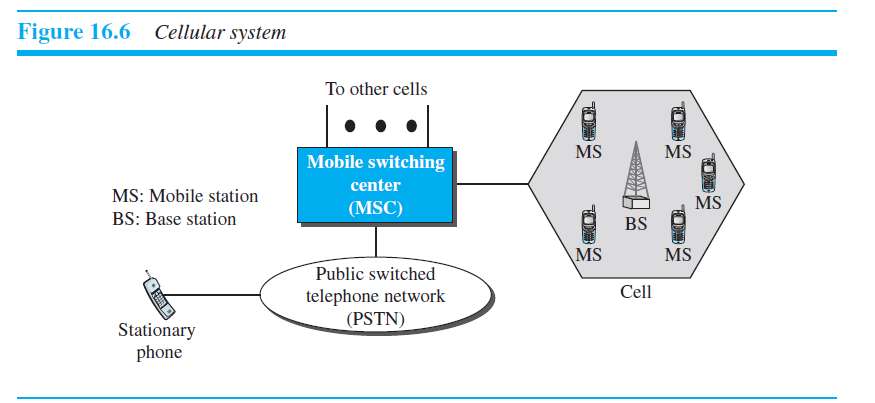
- 휴대폰의 무선 연결은 BS까지
- 기지국과 연결이 되는 범위가 Cell이다. (가상의 공간)
- BS과 MSC는 유선으로 연결이 된다. (서울-부산이면 기지국까지만 무선으로 연결된다.)
- 하나의 MSC에 연결의 Cell들이 연결돼 있다.
- BS는 생각보다 하는 역할이 없다.
Frequency-reuse Principle

- In a pattern with reuse factor 4, only one cell separates the cells using the same set of frequencies.
- 각 셀마다 주파수를 다른 주파수를 사용한다. (왼쪽 그림은 최소한 네 개의 서로 다른 주파수가 있어야 한다.)
- 같은 주파수를 사용하면 통신을 하는 데에 방해를 받는다.
- 그래도 혹시 파란 1번이 회색 1번까지 갈 수 있으니, 조금 더 안심하게 하기 위해서, 오른쪽 그림은 7개 셀을 사용한다.)
- 위의 설명을 reuse factor라고 한다. (7개 말고도 더 늘릴 수 있다.)
- 서울과 지방 SBS radio 주파수가 다른 것이 그 원리이다.
- 차를 몰고 가다 보면, 점점 다른 지역으로 가게 되면 라디오가 지직거린다. (각 지역의 주파수를 찾아서 맞추어야 한다.)
Transmitting
- The mobile station scans the band, seeking a setup channel with a strong signal, and sends the data (phone number) to the closest base station using that channel.
- The base station relays the data to the MSC.
- The MSC sends the data on to the telephone central office.
- If the called party is available, a connection is made and the result is relayed back to the MSC.
- mobile station이 band를 스캔한다. (나의 기지국이 어디있지?)
- 인접 기지국들에서 신호가 잡히는데, strong signal이 오는 곳의 기지국과 연결을 한다.
- 휴대전화에서 이제 data를 보내면, BS에서 그 data를 MSC로 relay한다.
- MSC는 다시 telephone central office로 data를 전송하고, 알맞은 원격지로 data가 찾아가게 된다.
Receiving
- MSC는 자기 자신이 관장하는 cell들에게 paging이라는 것을 보낸다.
- 통상적으로 그 번호가 어디 있는지 알고 있다. (전화를 했는데, 상대 전화기가 꺼져 있다면 그 어느 MSC에도 존재하지 않는 것이다.)
- 내가 전화하려는 mobile station은 어느 기지국에 있는 것인가? (paging)
- 어느 곳에 있다는 것을 알게 되면, call setup이 연결되고, 전화가 된다.
- MSC searches for the location of the mobile station by sending query signals to each cell in a process called paging
- MSC transmits a ringing signal and, when the mobile station answers, assigns a voice channel to the call.

Handoff
-
The mobile station moves from one cell to another. When it does, the signal may become weak. The MSC seeks a new cell that can better accommodate the communication.
-
한 셀에서 다른 셀로 가는 것을 handoff라고 한다.

-
Hard Handoff
-
Communication must first be broken with the previous base station before communication can be established with the new one. (a “break before make” connection)
-
break before make connection (통화가 안될 가능성이 생김)

-
hard handoff는 위험 부담이 있다.
-
새로 connection을 맺으려는 BS에 더 이상 선이 없어서, 수용이 안될 수도 있다.
-
Soft Handoff A mobile station can communicate with two base stations at the same time. During handoff, a station may continue with the new base station before breaking from the old one. (a “make before break” connection)
-
make connection before break (중간 구역에서는 양다리를 걸친다.)
-
딴 구역으로 들어가는 순간, 이전의 통신을 끊는다. 현재는 대부분 Soft Handoff를 사용한다.

Roaming
- Neighboring service providers can provide extended coverage through a roaming contract
- 예: 호주에 있는 사람이 영국으로 가도 서로 통신이 되는 구조

이동통신 서비스의 진화

- 와이브로는 지금 거의 사용되지 않음
First Generation
- subscriber line을 없애서 통신하려고 나온 것.
- it was designed for voice communication using analog signals.
- Advanced Mobile Phone System (AMPS)
- it uses FDMA(Frequency Division Multiple Access) to separate channels in a link
- AMPS operates in the band
- the system uses two separate analog channels for forward and reverse.
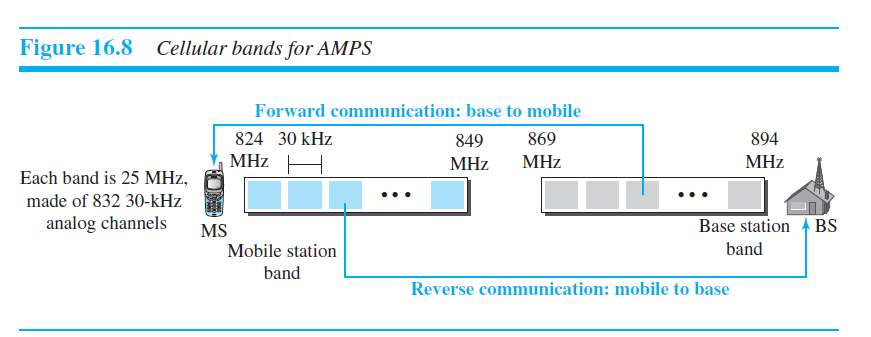
상기 그림에서
- Each band is , made of 832 analog channels.
- 이론상 832대가 동시에 통화가 가능하다.
- 채널을 할당해 주고, 그것으로 소통한다.
- 원래 목적이 subscriber line을 대체하는 것이라, ~ 사이의 사람 목소리 주파수 대역이 라 그리 설정했다.
- frequency modulation이라는 것을 사용하면, 폭이 로 늘어난다.
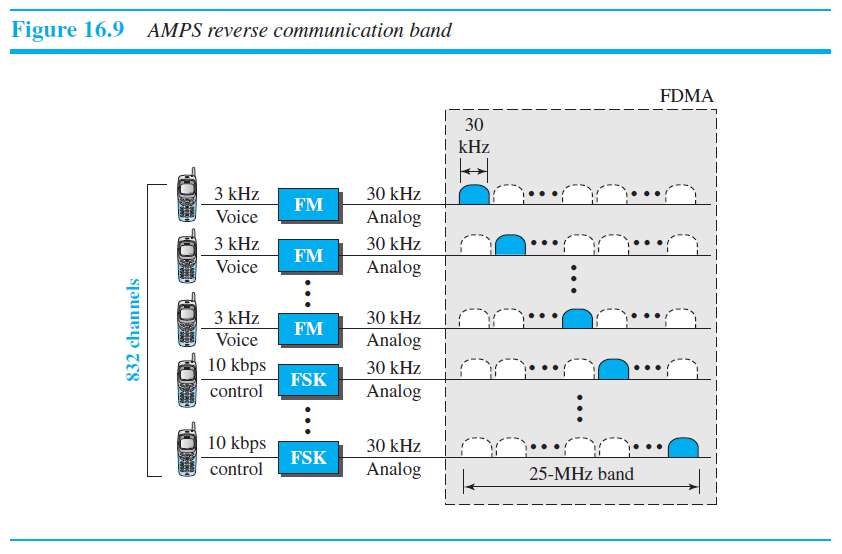
Second Generation (2G)

-
the second generation was mainly designed for digitized voice.
-
IS-136 D-AMPS
-
GSM
-
IS-95 CDMA
D-AMPS
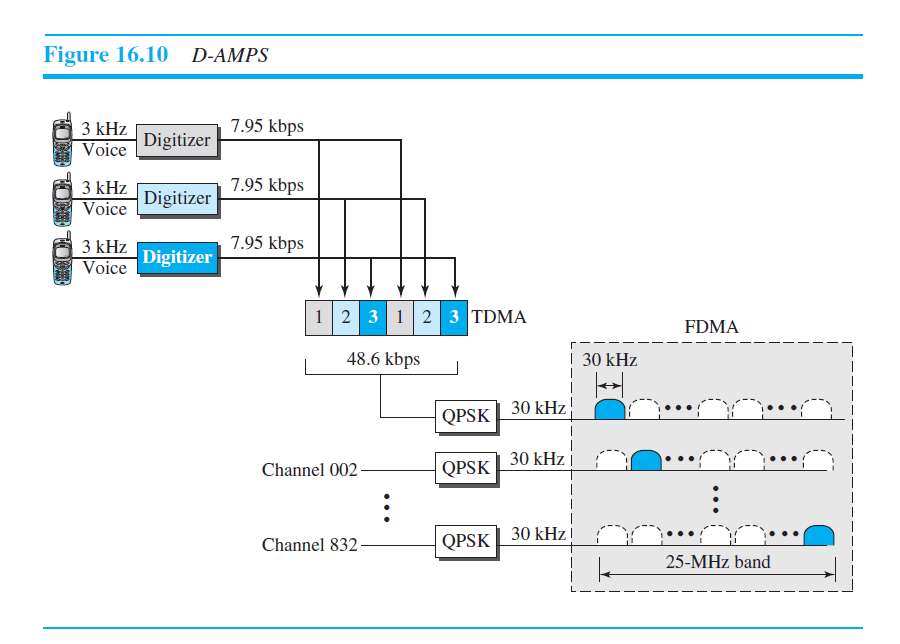
- digital로 변환하면서 기존에 비해 최대 3배 수용이 가능해졌다.
- 832개의 채널을 하나 뽑아서, 3대를 연결한다.
- time division multiple access (TDMA)를 사용해서 3배 수용이 가능해졌다.
- The evolution of the analog AMPS into a digital system is digital AMPS.
- D-AMPS uses the same bands and channels as AMPS.
- D-AMPS, or IS-136, is a di ital cellular hone s stem usingTDMA and FDMA.
GSM
- Global System for Mobile Communcation (유럽 표준)
- reuse factor: 3
- The Global System for Mobile Communication (GSM) is a European standard. The aim was to replace a number of incompatible 1G technologies.
- Because of the complex error correction mechanism, GSM allows a reuse factor as low as 3.
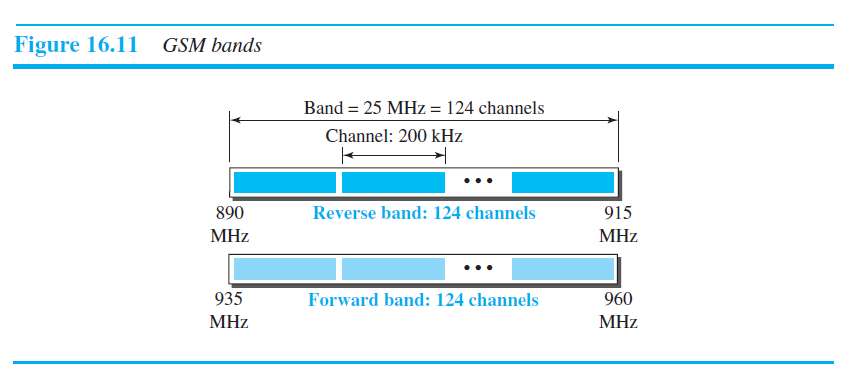
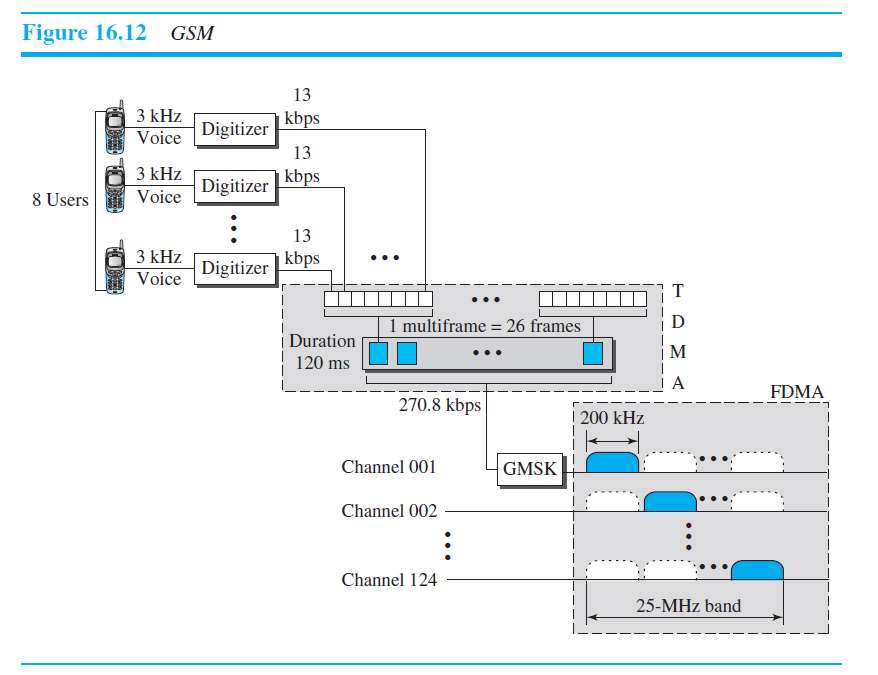
- GSM은 8명이 들어올 수 있다.
- 채널을 124개의 채널로 나누고, 한 채널은 이다.
- 한 채널에 8명이 들어 온다.
내부 프레임 구조:
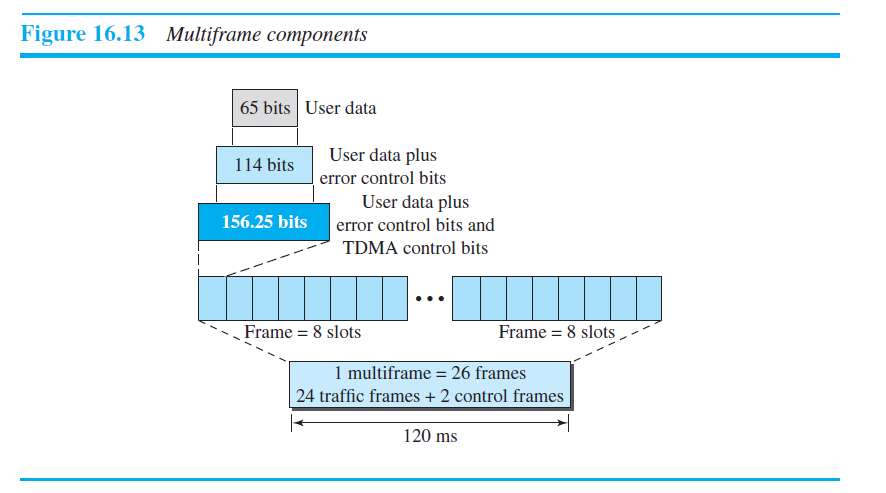
IS-95
- Interim Standaard 95, based on CDMA and DSSS (Direct Sequence Spread Spectrum)
- 이때 부터 GPS 지원
- Pilot channel sends a continuous stream of 1s to mobile station
- 디지털 통신이 가능했다.
- IS-95 defines two data rate sets
- first set: 9600, 4800, 2400, 1200bps
- second set: 14400, 7200, 3600, 1800bps
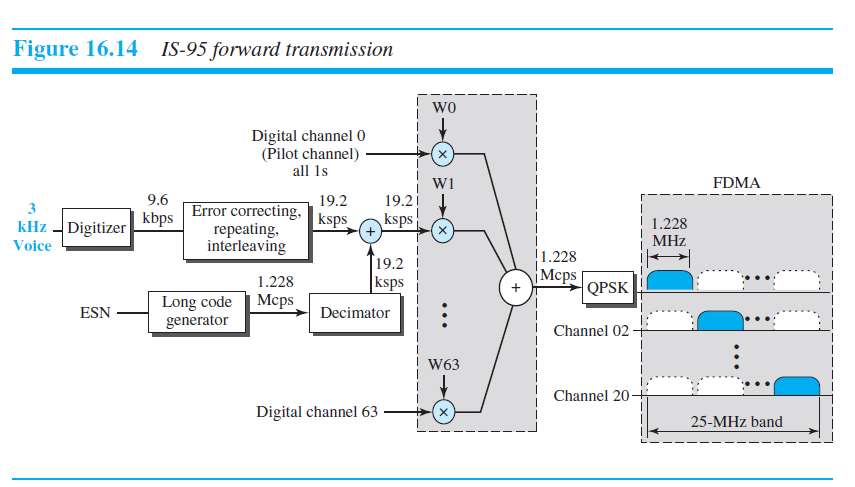
- 휴대폰 ESN(electornic serial number) 으로 사용자 식별 (이거와 음성을 섞어 채널로 쏜다.)
- 20개의 채널이 있다. 한 채널에 64명의 사용자를 수용할 수 있었다.
- 음성은 3kHz로 가정한다.
- 음성과 ESN을 섞어서 채널로 쏘는 구조였다.
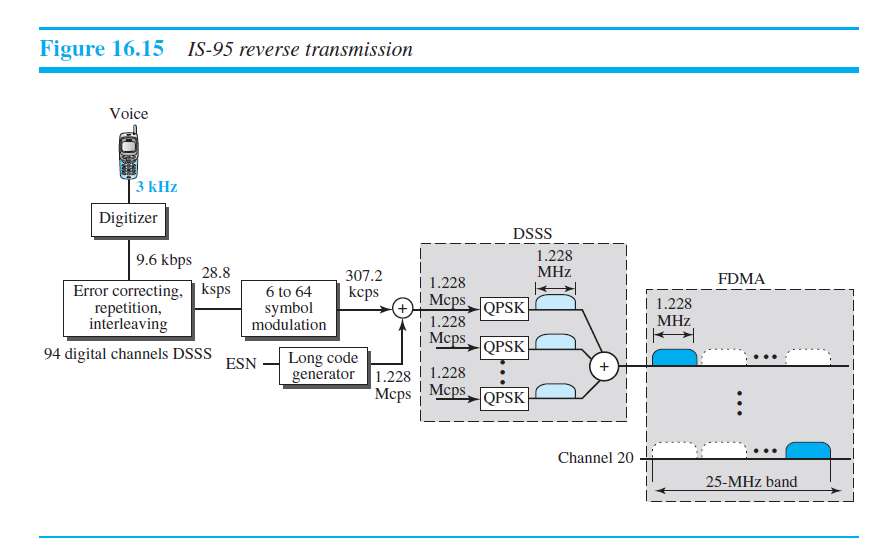
- 전화를 받을 때에도 ESN이 관련된다.
Third Generation
-
The 3G can provide both digital data and voice communication.
-
The 3G concept started in 1992, when ITU issued a blueprint called Internet Mobile Communication for year 2000 (IMT- 2000).
-
Some criteria for 3G technology as outlined the next slide.
-
provide both digital data and voice communication
-
Internet Mobile Communication for 2000 (IMT-2000)
-
voice quality comparable to that of the existing public telephone network
-
144Kbps, 384Kbps, 2Mbps
-
a band of 2GHz
-
bandwidth: 2MHz
-
인터넷 사용가능
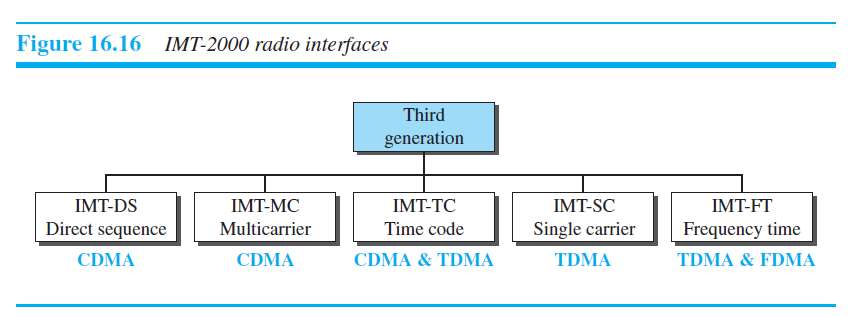
Fourth Generation (4G)
- data rate 100Mbps (moving car), 1Gbps for stationary user
- 모든 걸 IP packet으로 바꿔서 보내겠다. All IP, packet-switched, networks
- Some of the objectives defined by the 4G working group are as follows: A spectrally efficient system High network capacity
- Data rate of 100Mbps for access in a moving car and I Gbps for stationary users.
- Data rate of at least 100Mbps between any two points in the world.
- Smooth handoff across heterogeneous networks. High QoS for next generation multimedia support.
- Interoperability with existing wireless standards
- All IP, packet-switched. networks.